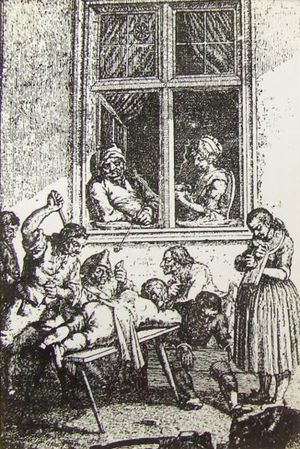Punishment
Punishment

Punishment is the practice of imposing something unpleasant on a subject as a response to some unwanted or immoral behavior or disobedience that the subject has displayed.
- to subject to pain, loss, confinement, death, etc., as a penalty for some offense, transgression, or fault: to punish a criminal.
- to inflict a penalty for (an offense, fault, etc.): to punish theft.
- to handle severely or roughly, as in a fight.
- to put to painful exertion, as a horse in racing.
- Informal. to make a heavy inroad on; deplete: to punish a quart of whiskey.
- to inflict punishment.
Punishment is different from discipline, in that punishment is a form of retribution as opposed to a form of training.
Mirror Punishment
A mirror punishment is a penal form of poetic justice which reflects the nature or means of the crime in the means of (often physical) punishment as a form of retributive justice - the practice of "repaying" a wrongdoer 'in kind'.
It can be an application of the lex talionis ("an eye for an eye"), but is not always proportional justice, as a similar method may be used to produce a worse or milder effect than the crime it 'retaliates'.
The simplest method of mirror punishment is to enact the same action upon the criminal as the criminal perpetrated upon the victim. For example, thieves has the same amount of money taken from them as they stole; one who strikes another is struck in the same way; one who wilfully causes another persons death is killed; and so on.
Often, however, a more esoteric method of mirror punishment is used, which implies punishing the part of the victim's body used to commit the crime. Extreme examples include the amputation of the hands of a thief, as still permitted by Sharia law, or during the Middle Ages in Europe; or disabling the foot or leg of a runaway slave. Other examples include the punishment of adulterous women by the insertion of irritating substances into their vagina (in the past hot pokers were sometimes used), or the punishment of illegal homosexual intercourse by inserting harmful objects in the rectum. A less extreme example is the putting of soap into a child's mouth for using inappropriate language (referred to in English as "washing someone's mouth out with soap").
Another method to accomplish 'poetic justice' is to mirror the physical method of the crime, e.g. executing a murderer with his own weapon, or in a more far-fetched example, boiling a counterfeiter alive (because bullion is boiled to be minted).
Examples
Examples of judicial punishments:
- fines (payment)
- incarceration (prison)
- judicial corporal punishment (today no longer practiced in most countries)
- death penalty (today illegal in some countries)
Examples of punishments in parenting:
- mild forms of corporal punishment (e.g. spanking, today illegal in some countries)
- time-out (e.g. corner time)
- murgha (in India, Pakistan, and nearby)
- extra chores
- psychological punishment, such as:
- temporary removal of privileges, such as:
- withholding allowance
- grounding
- no supper, no dessert, etc.
- early bedtime
- no TV
- no computer
- confiscation (usually temporary) of a toy or other personal item
- separation from a pet
Examples of school punishments:
- time-out (e.g. corner time)
- humiliation in front of the class, e.g. wearing a dunce cap
- mild forms of corporal punishment (e.g. striking the hand, spanking or kneeling, today illegal in some countries)
- detention
- writing lines
- writing an essay on a fitting subject
- chores (such as cleaning the schoolroom)
Aims
At least three aims of punishment can be identified: revenge, repentance and deterrence. Revenge or vengeance consists of retaliation in response to perceived wrongdoing. Revenge is a hotly contested ethical issue in the post-industrial society, although modern game theory shows that without revenge it is impossible to maintain any society, let alone a just society. Repentance is the feeling and act in which one recognizes and tries to right a wrong, and gain forgiveness from someone that they wronged. Deterrence is a means of controlling a person's behavior through fear of punishment.
See also
- More information is available at [ Wikipedia:Punishment ]
- More information is available at [ Wikipedia:School punishment ]
Links
- Punishment on Psychology Wiki
- The Olden Time Series, Vol. 5: Some Strange and Curious Punishments (1886) on Project Gutenberg
| Types of Punishments | |||
|---|---|---|---|
Chat rooms • What links here • Copyright info • Contact information • Category:Root